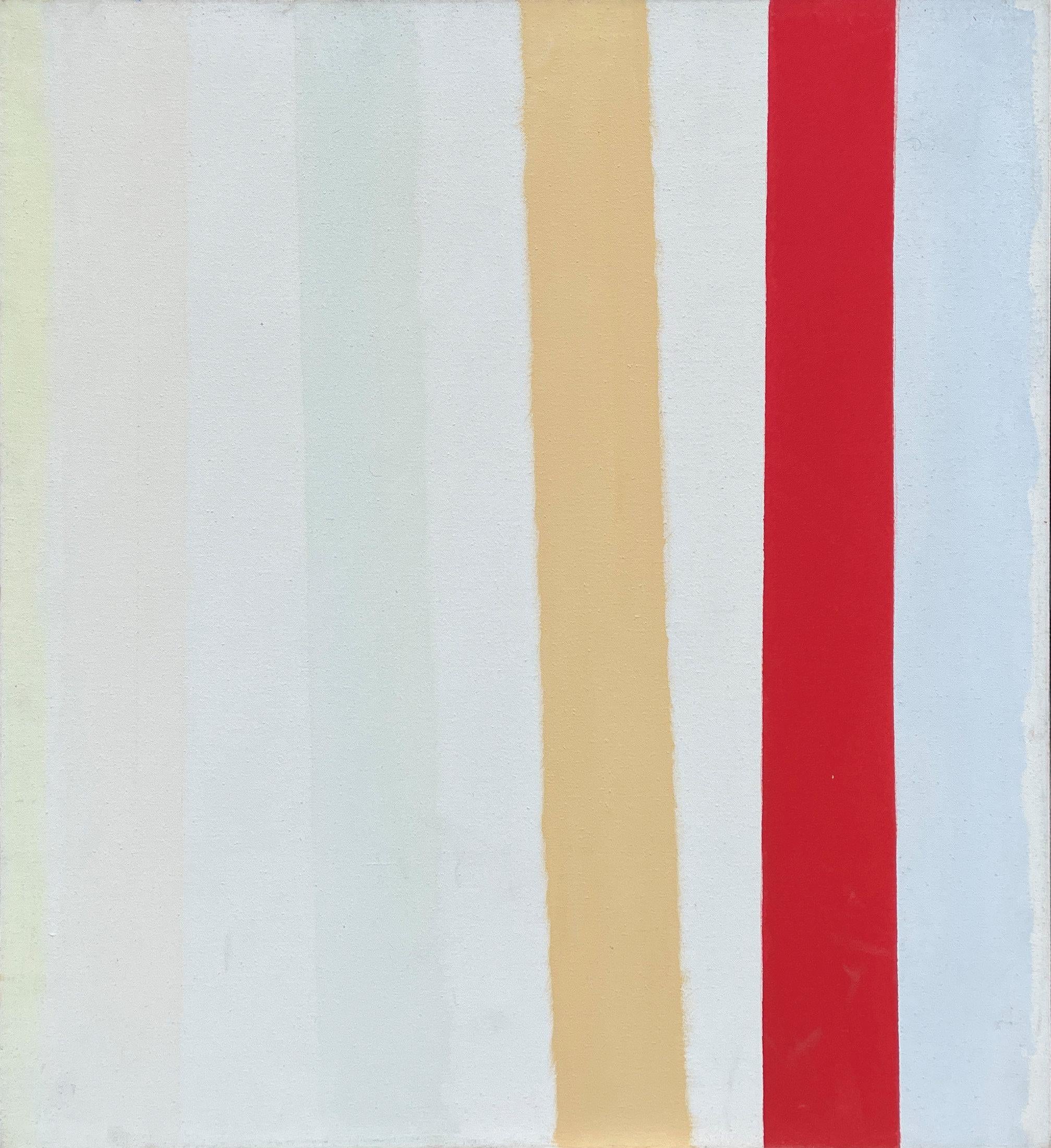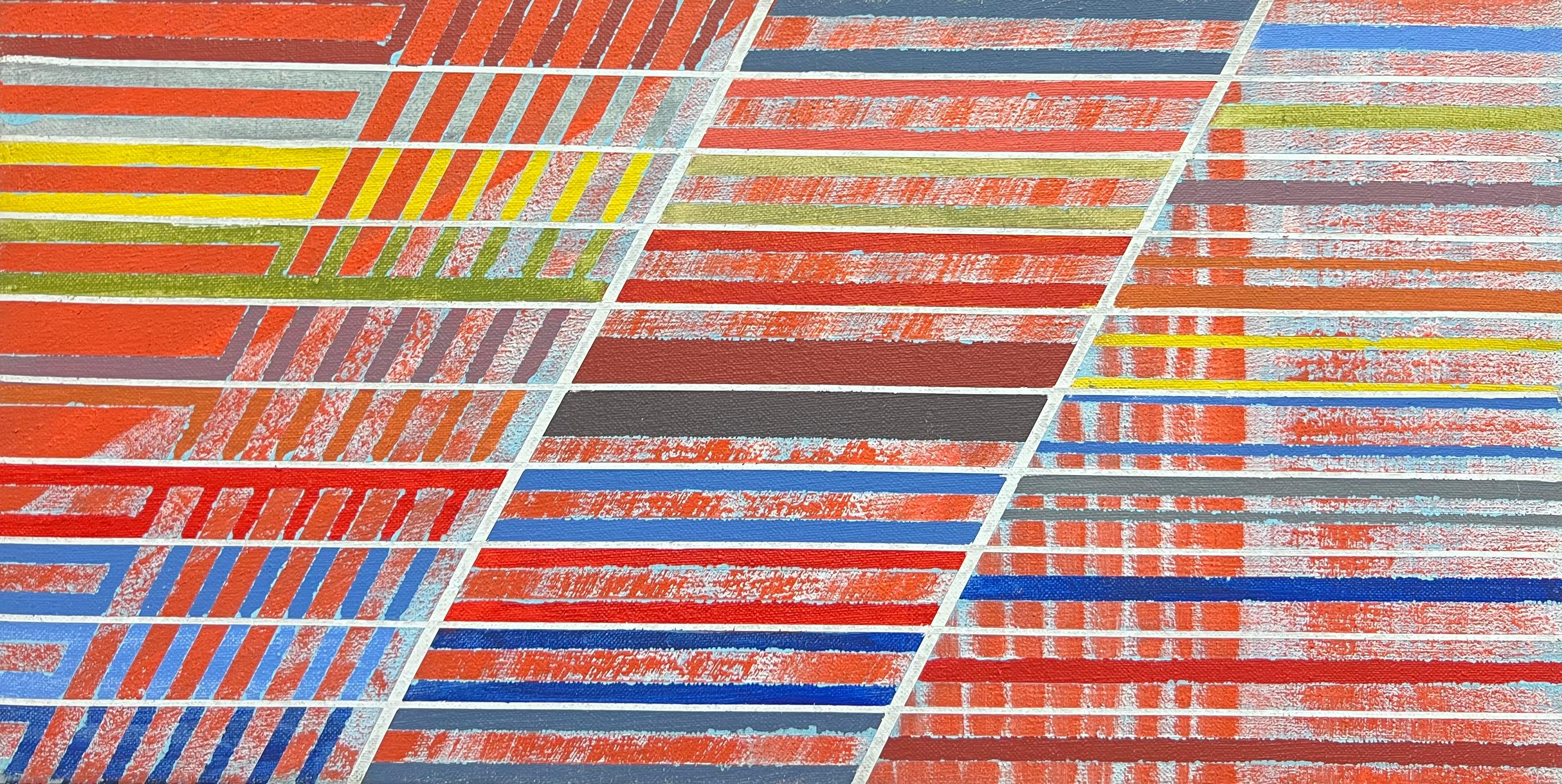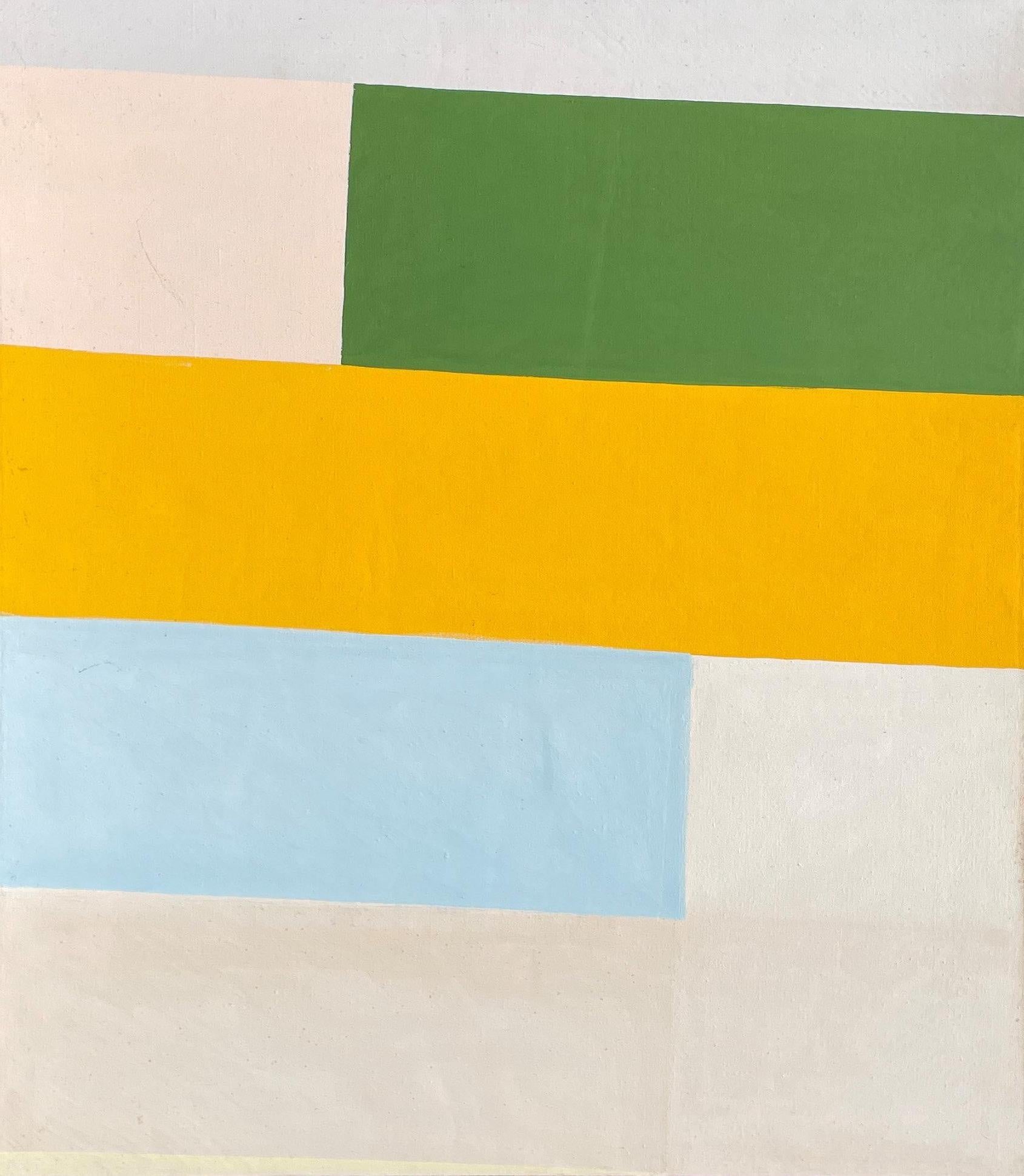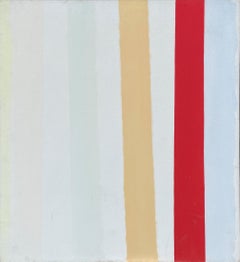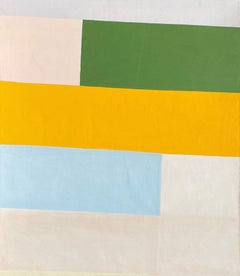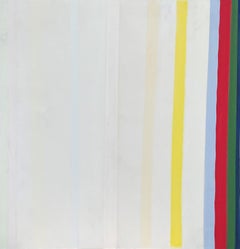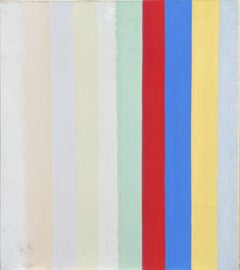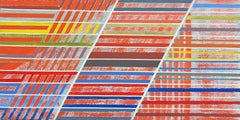Items Similar to "Untitled, " Jay Rosenblum, Hard-Edge Color Field, Colorful Horizontal Stripes
Want more images or videos?
Request additional images or videos from the seller
1 of 7
Jay Rosenblum"Untitled, " Jay Rosenblum, Hard-Edge Color Field, Colorful Horizontal Stripes1973
1973
$60,000
$80,00025% Off
£46,609.74
£62,146.3225% Off
€52,885.92
€70,514.5625% Off
CA$85,788.63
CA$114,384.8425% Off
A$93,854.91
A$125,139.8825% Off
CHF 49,018.63
CHF 65,358.1725% Off
MX$1,121,589.21
MX$1,495,452.2725% Off
NOK 615,852.30
NOK 821,136.3925% Off
SEK 579,614.25
SEK 772,818.9925% Off
DKK 394,943.80
DKK 526,591.7325% Off
About the Item
Jay Rosenblum (1933 - 1989)
Untitled, 1973
Acrylic on canvas
54 x 128 inches
Signed twice and dated on the reverse
Provenance:
Private Collection, Long Island
Jay Rosenblum experimented with different versions of the "Visual Stripe motif" for more than thirty years. In the 1960's he developed a "hard-edge" style with "flat curtain forms" which had a clearly defined vertical emphasis. These colors as in our example move up and down the picture plane. Space is defined by shifts in color passages. As the artist explained in his own words:
"The vertical forms in my work serve as the vehicle for color and also become a dramatic means of achieving movement and deep space. This becomes possible through a great variation in the stripe thickness and the sudden emergence or disappearance of a particular band of color when it overlaps another."
Rosenblum was an ardent violinist who played for the Seventh Army Symphony in West Germany and who was also an art teacher at the School of Visual Arts. In his art Rosenblum sought to associate his great love for chamber music sonatas with his freely evolving vertical stripes of color. Rosenblum once stated:
"When these elements engage themselves in the painting, there is a great visual excitement for me. A kinship with music, in a polyphonic sense, is very strong in that simultaneously one hears lines of "overlapping" music. In some mysterious way the composer can achieve this and it is equally mysterious and effective in painting when it happens."
In much the same way that singular notes strung together create music, individual stripes of color together can be transformed into a complete art form. He thus viewed these blocks of color almost as separate notes in a piece of music that that when brought together would be transformed into a cohesive unit, resonating with a playfulness that added interest and energy to the picture. With colors Rosenblum attempted to select ones that when juxtaposed against or near one another would become "an exciting visual discovery". He would refer to such works as "free association color development". Rosenblum executed a number of these "hard-edge" paintings which included groupings of color clusters in both vertical and diagonal motifs.
Jay Rosenblum was born in New York City in 1933. He attended the Pratt Institute in Brooklyn from 1951-53, Harvard University in the summer of 1953 and Bard College in Annandale-on-Hudson, NY 1953-1955. He received a M.F.A. from Cranbrook Academy of Art in Bloomfield Hills, MI. His paintings have appeared in numerous selected solo and group exhibitions in the USA and Italy. Rosenblum was awarded the Carlos Lopez Memorial Prize in painting from the Detroit Institute of Art in Detroit, Michigan in 1955 and the Painter of the Year Award from Larry Aldrich, Ridgefield, CT in 1970. He lived and worked in Manhattan for most of his life and sadly died in a tragic bicycle accident in 1989.
Jay Rosenblum
Jay Rosenblum experimented with different versions of the "Visual Stripe motif" for more than thirty years. In the 1960's he developed a "hard-edge" style with "flat curtain forms" which had a clearly defined vertical emphasis. These colors as in our example move up and down the picture plane. Space is defined by shifts in color passages. As the artist explained in his own words: "The vertical forms in my work serve as the vehicle for color and also become a dramatic means of achieving movement and deep space. This becomes possible through a great variation in the stripe thickness and the sudden emergence or disappearance of a particular band of color when it overlaps another." Rosenblum was an ardent violinist who played for the Seventh Army Symphony in West Germany and who was also an art teacher at the School of Visual Arts. In his art Rosenblum sought to associate his great love for chamber music sonatas with his freely evolving vertical stripes of color. Rosenblum once stated: "When these elements engage themselves in the painting, there is a great visual excitement for me. A kinship with music, in a polyphonic sense, is very strong in that simultaneously one hears lines of "overlapping" music. In some mysterious way the composer can achieve this and it is equally mysterious and effective in painting when it happens." In much the same way that singular notes strung together create music, individual stripes of color together can be transformed into a complete art form. He thus viewed these blocks of color almost as separate notes in a piece of music that that when brought together would be transformed into a cohesive unit, resonating with a playfulness that added interest and energy to the picture. With colors Rosenblum attempted to select ones that when juxtaposed against or near one another would become "an exciting visual discovery". He would refer to such works as "free association color development". Rosenblum executed a number of these "hard-edge" paintings which included groupings of color clusters in both vertical and diagonal motifs. Jay Rosenblum was born in New York City in 1933. He attended the Pratt Institute in Brooklyn from 1951-53, Harvard University in the summer of 1953 and Bard College in Annandale-on-Hudson, NY 1953-1955. He received a M.F.A. from Cranbrook Academy of Art in Bloomfield Hills, MI. His paintings have appeared in numerous selected solo and group exhibitions in the USA and Italy. Rosenblum was awarded the Carlos Lopez Memorial Prize in painting from the Detroit Institute of Art in Detroit, Michigan in 1955 and the Painter of the Year Award from Larry Aldrich, Ridgefield, CT in 1970. He lived and worked in Manhattan for most of his life and sadly died in a tragic bicycle accident in 1989.
About the Seller
5.0
Platinum Seller
Premium sellers with a 4.7+ rating and 24-hour response times
Established in 2022
1stDibs seller since 2022
129 sales on 1stDibs
Typical response time: <1 hour
- ShippingRetrieving quote...Shipping from: New York, NY
- Return Policy
Authenticity Guarantee
In the unlikely event there’s an issue with an item’s authenticity, contact us within 1 year for a full refund. DetailsMoney-Back Guarantee
If your item is not as described, is damaged in transit, or does not arrive, contact us within 7 days for a full refund. Details24-Hour Cancellation
You have a 24-hour grace period in which to reconsider your purchase, with no questions asked.Vetted Professional Sellers
Our world-class sellers must adhere to strict standards for service and quality, maintaining the integrity of our listings.Price-Match Guarantee
If you find that a seller listed the same item for a lower price elsewhere, we’ll match it.Trusted Global Delivery
Our best-in-class carrier network provides specialized shipping options worldwide, including custom delivery.More From This Seller
View All"A Stripe" Calvert Coggeshall, Abstract Expressionism, Hard-edge Vertical Lines
Located in New York, NY
Calvert Coggeshall
A Stripe, 1971
Signed, titled, and dated on the reverse
Acrylic on canvas
30 x 30 inches
Calvert Coggeshall worked as an abstrac...
Category
1970s Abstract Expressionist Abstract Paintings
Materials
Canvas, Acrylic
"Untitled" Calvert Coggeshall, Abstract Expressionism Hard-edge Stripes
Located in New York, NY
Calvert Coggeshall
Untitled, circa 1975
Oil on canvas
50 x 40 inches
Calvert Coggeshall worked as an abstract painter and interior designer primari...
Category
1970s Abstract Expressionist Abstract Paintings
Materials
Canvas, Acrylic
"Notes I" Calvert Coggeshall, Abstract Expressionism Hard-edge Vertical Stripes
Located in New York, NY
Calvert Coggeshall
Notes I, 1970-80
Signed, titled, and dated on the reverse
Acrylic on canvas
65 x 67 inches
Calvert Coggeshall worked as an abstr...
Category
1970s Abstract Expressionist Abstract Paintings
Materials
Canvas, Acrylic
"Notes XXI" Calvert Coggeshall, Abstract Expressionism Hardedge Vertical Stripes
Located in New York, NY
Calvert Coggeshall
Notes XXI, 1973
Signed, titled, and dated on the reverse
Japanese pigment on canvas
29 x 29 inches
Calvert Coggeshall worked as ...
Category
1970s Abstract Expressionist Abstract Paintings
Materials
Canvas, Acrylic
"Meridian" Calvert Coggeshall, Abstract Expressionism Hard-edge Vertical Stripes
Located in New York, NY
Calvert Coggeshall
Meridian, 1974
Signed, titled, and dated on the reverse
Acrylic on canvas
67 x 45 inches
Calvert Coggeshall worked as an abstrac...
Category
1970s Abstract Expressionist Abstract Paintings
Materials
Canvas, Acrylic
"Illumination" Calvert Coggeshall, Abstract Expressionism, Hard-edge Stripes
Located in New York, NY
Calvert Coggeshall
Illumination, 1973
Signed, titled, and dated on the reverse
Acrylic on canvas
65 x 67 inches
Calvert Coggeshall worked as an abs...
Category
1970s Abstract Expressionist Abstract Paintings
Materials
Canvas, Acrylic
You May Also Like
Red Black and White Stripes, Abstract Geometric Oil Painting by Warner Friedman
By Warner Friedman
Located in Long Island City, NY
Artist: Warner Friedman, American (1935 - )
Title: Red, Black and White Stripes
Year: circa 1965
Medium: Oil on Canvas, signed on label verso
Size: 28 in. x 21 in. (71.12 cm x 53.34...
Category
1960s Color-Field Abstract Paintings
Materials
Canvas, Oil
French 20th Century Vibrant Geometric Abstract Multicolored Stripes
Located in Cirencester, Gloucestershire
Abstract Expressionist Composition
by Gilbert Pelissier (French born 1924)
oil painting on canvas, unframed
canvas size: 8 x 16 inches
condition: overall very good, a few minor surf...
Category
Late 20th Century Abstract Expressionist Abstract Paintings
Materials
Canvas, Oil
$632 Sale Price
30% Off
Gradient X, Abstract Minimalist Colorfield Acrylic Painting by Jay Rosenblum
By Jay Rosenblum
Located in Long Island City, NY
This acrylic painting on paper was created by New York-born artist Jay Rosenblum. In his art, he seeks to correlate his great love for chamber music sonatas with freely evolving bloc...
Category
1970s Abstract Abstract Paintings
Materials
Paper, Acrylic
Candy Stripes X, Geometric Abstract Painting by Dan Teis
By Dan Teis
Located in Long Island City, NY
Artist: Dan Teis
Title: Candy Stripes X
Year: 1979
Medium: Acrylic on Canvas, Signed l.r.
Size: 48 x 64 in. (121.92 x 162.56 cm)
Frame Size: 49.5 x 65.5 inches
Category
1970s Abstract Geometric Abstract Paintings
Materials
Canvas, Acrylic
"Color Moves" Abstract, Geometric, Linear, Colorful
Located in Detroit, MI
"Color Moves" is a colorful abstract with a broad linear element. Artist David Rubello studied and painted naturalism for many years. In 1965 he began s...
Category
2010s Abstract Geometric Abstract Paintings
Materials
Acrylic
Horizontal Abstract Expressionist Painting with Multicolor Stripes, Modern Art
By Robert Natkin
Located in NEW YORK, NY
Robert Natkin
Apollo, 617, 1982
Acrylic on canvas
48 x 55 inches
RNa085
Celebrated as an unsurpassed colorist and for the beauty of his large-scale abstract works, Robert Natkin was...
Category
1980s Abstract Expressionist Abstract Paintings
Materials
Canvas, Acrylic
More Ways To Browse
1970 Hard Edge Painting
Japanese Traditional Art
Metropolitan Gallery
Theatre Costumes
Used Building Materials
Vintage Clown Art
19th Century Oil Painting Boy
Antique Painting Boy
Campbells Soup
Contemporary Outdoor Sculptures
In Despair
Kate Moss Art
French Artist Poster
Pharrell Williams
Serigraph Prints Signed
Bis Vintage
Denise Rene
Frame Print 18th Century
